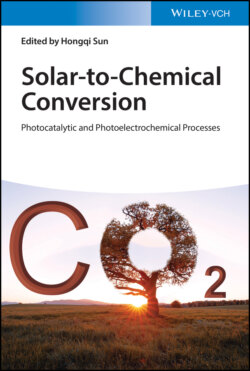Читать книгу Solar-to-Chemical Conversion - Группа авторов - Страница 16
2.3 Principles of Photocatalysis
ОглавлениеThe term “photocatalysis” is often used in papers on catalytic reaction excited by simulated or natural light irradiation, where a catalyst has been used as a reaction center [11]. To simulate the efficient natural photosynthesis reaction, the use of a catalyst is inevitable in the view of physiochemical field. Because biological scientists find that in leave cells the enzyme is the key role in prompting the non‐thermodynamic reaction, i.e. carbon dioxides reacting with water to produce dioxygen and hydrocarbons. Therefore, to accelerate this reaction under certain conditions, a photocatalyst often is used as similar in many industrial fields, such as sulfuric acid products, synthetic ammonia, and syngas. As shown in Figure 2.3, in general, there are many active sites existing on the surface of catalyst, which can act as reaction site and accelerate the transformation of substrates to products under certain reaction conditions [12]. Similarly, the catalytic reaction process is triggered at the active sites on the surface of photocatalyst under light irradiation. It is reported that the electrons and holes can be produced in the photocatalysts, which further participate the redox reaction [13].
Figure 2.3 (a) Traditional catalytic processeson the surface of catalysts. (b) Classic photocatalytic paths over photocatalysts.
In photocatalysis, many photocatalysts have been developed and investigated in the past decades [14]. Here, taking excessively studied semiconductor photocatalyst as an example, the whole photocatalytic process is described. Semiconductor is a kind of material with electrical conductivity between conductor (such as metals) and insulator (such as ceramic) [15]. The conductivity of a semiconductor usually increases with the increase of the temperature, which is opposite to that of a metal. The unique electronic property of a semiconductor is characterized by its valence band (VB) and conduction band (CB). The VB of a semiconductor is formed by the interaction of the highest occupied molecular orbital (HOMO), while the CB is formed by the interaction of the lowest unoccupied molecular orbital (LUMO). There is no electron state between the top of the VB and the bottom of CB. The energy range between CB and VB is called forbidden band gap (also called energy gap or bandgap), which is usually denoted as Eg, as shown in Figure 2.4.
Figure 2.4 A band‐gap diagram showing the different sizes of band gaps for conductors, semiconductors, and insulators.
The band structure, including the band gap and the positions of VB and CB, is one of the important properties for a semiconductor photocatalyst, because it determines the light absorption property as well as the redox capability of a semiconductor [16]. As shown in Figure 2.5, the photocatalytic reaction initiates from the generation of electron–hole pairs upon light irradiation. When a semiconductor photocatalyst absorbs photons with energy equal to or greater than its Eg, the electrons in VB will be excited to CB, leaving the holes in VB. These photogenerated electron–hole pairs may further be involved in the following three possible processes: (i) successfully migrate to the surface of semiconductor, (ii) be captured by the defect sites in bulk and/or on the surface region of semiconductor, and (iii) recombine and release the energy in the form of heat or photon. The last two processes are generally viewed as deactivation processes because the photogenerated electrons and holes do not contribute to the photocatalytic reaction. Only the photogenerated charges that reached to the surface of semiconductor could be available for photocatalytic reactions. The defect sites in the bulk and on the surface of semiconductor may serve as the recombination centers for the photogenerated electrons and holes, which will decrease the efficiency of the photocatalytic reaction.
Figure 2.5 Proposed mechanism of photocatalytic reactions on semiconductor photocatalysts.
Source: Ma et al. [16].
Efficient charge separation is the most important factor that determines the photocatalytic activities. Various strategies could be applied for improving charge separation efficiency [17]. For example, preparation of semiconductor photocatalysts at high temperatures may lead to high crystallinity that diminishes the formation of charge recombination defect sites. Construction of various kinds of nanostructures such as nanowires (belts) and nanosheets may also facilitate charge transportation and promote charge separation efficiency. As compared to nanoparticle, one‐dimensional nanostructures exhibit better photocatalytic activity because they have better charge mobility and can reduce the charge recombination. Furthermore, creation of “junctions” with built‐in electric fields or chemical potential differences is also an effective strategy for improving charge separation efficiency [18]. The surface catalytic reaction is a successive step of charge separation. In principle, a photocatalytic reaction consists of two half‐reactions, reduction reaction and oxidation reaction. The electrons in CB may initiate the reduction reaction, and the reduction capability is determined by the position of CB; the holes in the VB involve the oxidation reaction, and the oxidation capability is determined by the position of VB. For the water splitting reaction, the position of CB of a semiconductor photocatalyst should be more negative than the redox potential of H+/H2 (0 V vs. normal hydrogen electrode [NHE], pH = 7), while the energy level of VB should be more positive than the redox potential of O2/H2O (1.23 V vs. NHE, pH = 7). Sometimes, some particular surface sites of a semiconductor can act as the active centers themselves, especially for oxidation reaction on the surface of metal oxide semiconductors. However, in most cases, efficient photocatalytic reactions proceed only after loading noble metal and oxide cocatalysts on semiconductors.
